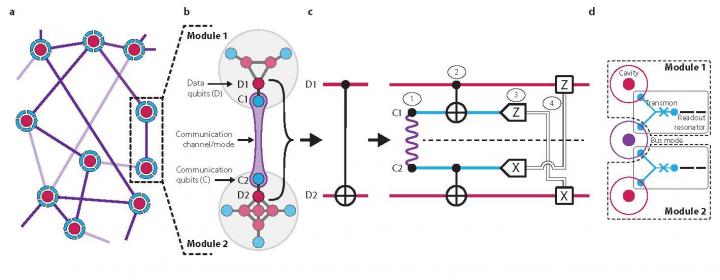
This is network overview of the modular quantum architecture demonstrated in the new study. Credit: Yale University
Yale University researchers have demonstrated one of the key steps in building the architecture for modular quantum computers: the “teleportation” of a quantum gate between two qubits, on demand.
The findings appear online Sept. 5 in the journal Nature.
The key principle behind this new work is quantum teleportation, a unique feature of quantum mechanics that has previously been used to transmit unknown quantum states between two parties without physically sending the state itself. Using a theoretical protocol developed in the 1990s, Yale researchers experimentally demonstrated a quantum operation, or “gate,” without relying on any direct interaction. Such gates are necessary for quantum computation that relies on networks of separate quantum systems — an architecture that many researchers say can offset the errors that are inherent in quantum computing processors.
Through the Yale Quantum Institute, a Yale research team led by principal investigator Robert Schoelkopf and former graduate student Kevin Chou is investigating a modular approach to quantum computing. Modularity, which is found in everything from the organization of a biological cell to the network of engines in the latest SpaceX rocket, has proved to be a powerful strategy for building large, complex systems, the researchers say. A quantum modular architecture consists of a collection of modules that function as small quantum processors connected into a larger network.
Modules in this architecture have a natural isolation from each other, which reduces unwanted interactions through the larger system. Yet this isolation also makes performing operations between modules a distinct challenge, according to the researchers. Teleported gates are a way to implement inter-module operations.
“Our work is the first time that this protocol has been demonstrated where the classical communication occurs in real-time, allowing us to implement a ‘deterministic’ operation that performs the desired operation every time,” Chou said.
Fully useful quantum computers have the potential to reach computation speeds that are orders of magnitude faster than today’s supercomputers. Yale researchers are at the forefront of efforts to develop the first fully useful quantum computers and have done pioneering work in quantum computing with superconducting circuits.
Quantum calculations are done via delicate bits of data called qubits, which are prone to errors. In experimental quantum systems, “logical” qubits are monitored by “ancillary” qubits in order to detect and correct errors immediately. “Our experiment is also the first demonstration of a two-qubit operation between logical qubits,” Schoelkopf said. “It is a milestone toward quantum information processing using error-correctable qubits.”



